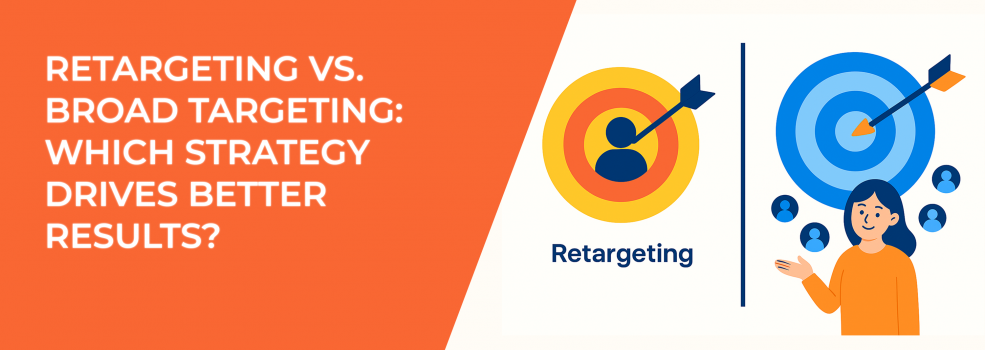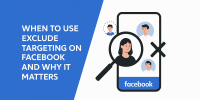Facebook’s ad landscape keeps shifting, and smart marketers often debate a single fork in the road: should you double-down on facebook retargeting, or let Facebook broad targeting hunt for entirely new prospects? Below we unpack both options, weigh their pros and cons, and talk through real-world steps that help you choose and blend them for maximum return.
Why this debate matters right now
A quick history lesson helps frame the conversation. During the past year Meta removed detailed targeting exclusions and quietly enabled location expansion for many ad accounts. When brands stopped excluding audiences, Meta saw a noticeable drop in average cost per conversion. Turning on location expansion then trimmed another 6.7% off cost per result for early testers. In plain English, the algorithm is doing more of the targeting work — so our job is to know when to trust the robot and when to add human steering.
Warm leads first: what retargeting really does
Retargeting serves ads to people who already interacted with your brand—visited your site, watched half of a video, or liked a post. Because these folks are warm, retargeting is the natural closer that nudges them from thinking to buying. (Need a step-by-step refresher? Our illustrated retargeting guide covers every pixel and event.)
Before we dive into tactics, let’s remind ourselves why marketers love retargeting and where it can sting.
Pros:
-
Higher conversion potential — warm users need fewer touches to buy.
-
Lower acquisition cost — you pay to re-engage, not to discover.
-
Personalized creative — dynamic ads can show the exact product someone viewed.
Cons:
-
Finite audience size — without new traffic, sales plateau.
-
Frequency fatigue — small lists see the same ad repeatedly.
-
Pixel dependence — bad event tracking wipes out your pool.
So how do you lock in the upside without suffering the downside? The mini-playbook below is the routine many brands run on Monday mornings before campaigns go live.
-
Install the Meta Pixel and Conversions API — redundancy keeps data flowing if one signal breaks.
-
Build three core segments — site visitors 30 days, product viewers 14 days, cart abandoners 7 days.
-
Cap frequency at 6-8 impressions a week — too many views tank click-through rate.
-
Refresh creative every two weeks — swap in UGC or new headlines to stay relevant.
-
Exclude recent buyers from prospecting sets — they move straight into a post-purchase flow.
Run those steps and retargeting becomes a predictable closer that keeps cost per purchase low.
Casting the wide net: how broad targeting works
Now let’s flip to the top of the funnel. Broad targeting removes most filters and lets Meta’s machine learning roam free. Since 2024, Advantage Detailed Targeting has become the default setting for traffic and engagement objectives—a sign that Facebook wants elbow-room to learn.
Here’s the elevator pitch for — and against — going broad.
Pros:
-
Algorithmic scale — Meta hunts across entire regions for converters.
-
Future-proofing — fewer rules mean fewer compliance headaches.
-
Time savings — you test creative, not endless audience slices.
Cons:
-
Slower learning curve — early dollars teach the algorithm, not the bottom line.
-
Creative pressure — bland stock photos rarely pull a click.
-
Possible waste in niche markets — relevance can drop.
Of course, broad targeting isn’t “set and forget.”
The points below help guide Meta without clipping its wings:
-
Start with one country and language — expand only after cost stabilizes.
-
Optimize for a single goal — purchase or lead, never both.
-
Aim for 50 conversions a week per ad set — raise budget or consolidate if you’re short.
-
Test Advantage+ Shopping — many stores see better ROAS with it.
-
Review placements every Friday — pause any that sit 20% over your target CPA for two straight weeks.
With those guardrails in place, broad targeting becomes a dependable finder of new customers.
Where the two tactics meet and why you need both
Think of retargeting as a sniper — hyper-accurate but useless without a target. Broad targeting is a trawler — it casts a wide net and relies on sorting later. The smartest advertisers run them in tandem: broad fills the funnel with fresh curiosity, then retargeting steps in to finish the sale at a friendly cost.
Five quick questions to guide tomorrow’s budget chat
Before you shuffle dollars, gather your team and run through these prompts:
-
Budget size — spending under $100/day? Let retargeting keep 30%. Pushing past $1k/day? Broad can take 80%.
-
Pixel data depth — fewer than 100 purchases in 30 days? Pump broad traffic first so the pixel has data to chew on.
-
Product type — impulse buys thrive on broad discovery; high-ticket items need retargeting nurture.
-
Market saturation — mature brands often max out retargeting pools and lean on broad for growth.
-
Creative bandwidth — broad wants new ads weekly; if that’s tough, anchor on evergreen retargeting.
Treat those answers as guideposts , not hard rule, and your campaigns will run much more smoother.
Blending tactics: a quick discussion of advanced plays
Once both engines hum along, a few tweaks can squeeze extra profit out of the system:
-
Content funnel. Lead with a broad video that frames the pain point. Anyone who watches 50% moves to a testimonial retargeting ad, and cart abandoners then see a limited-time discount.
-
Value-based lookalikes. Export your top-10% LTV customers, build a lookalike, then switch on broad expansion. The algorithm starts with proven spenders and widens the radius.
-
Location expansion test. After dominating your core city, toggle “Reach more people likely to respond.” Many brands see a 5-10% CPA dip within a week.
-
Offer rotation. Change the hook every four weeks — 10% off, free shipping, bundle deal — to keep click rates healthy.
-
Automated rules. Set “If frequency > 9 and CTR < 0.5%, pause ad.” That single rule keeps small retargeting pools from burnout.
Each play adds a layer of control without forcing you to micromanage every knob.
Don’t forget the Facebook ad policy backdrop
Two updates dominate the 2025 compliance agenda:
-
Customer-list certification becomes mandatory for U.S. housing, employment, and finance campaigns. Clean your CRM data now so uploads pass Meta’s new scanner.
-
Special ad categories expand — “financial products and services” replaces “credit,” tightening targeting levers. Broaden messaging early so you’re not scrambling later.
For the full rundown, check our discussion on adapting to Meta’s 2025 targeting changes.
Bottom line
There’s no single winner. Broad targeting brings you new people; retargeting turns them into customers. Start with the tactic your numbers support, keep testing creative, and let Meta’s smarter-by-the-day algorithm do more of the heavy lifting. Brands that adapt quickly and share what they learn will keep winning long after the next update rolls out.
You can learn more in our Facebook Ad Targeting 101 guide.

